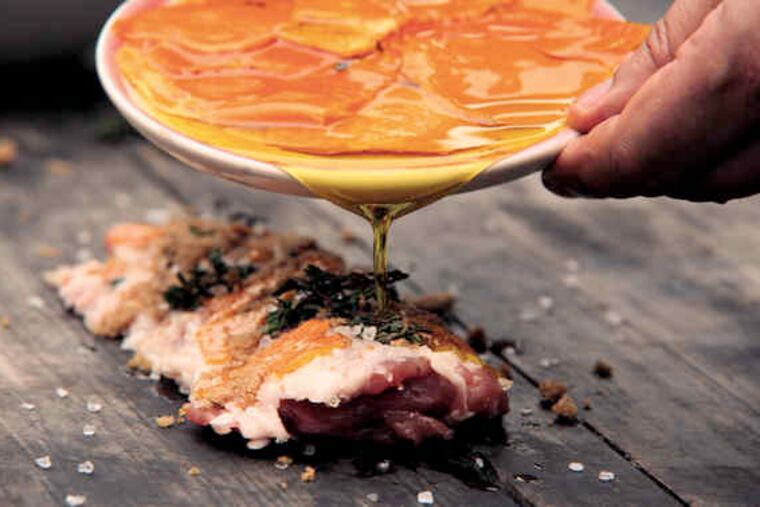Blaze that beef: Grilling the Argentine way
CLASSICAL GREEK literature is not the first source most North Americans would turn to in making an analogy about grilling, but then how many of them have ever seen Argentine grilling in action? Steven Raichlen has.

CLASSICAL GREEK literature is not the first source most North Americans would turn to in making an analogy about grilling, but then how many of them have ever seen Argentine grilling in action? Steven Raichlen has.
"Argentine grilling is the most heroic grilling in the Homerian sense," said the Miami-based grill expert and author. Homer, of course, was a legendary poet, author of ancient Greece's most sweeping war epic, "The Iliad."
"It's very primal. No adornment. Nothing fancy. No elaborate marinades," Raichlen added. "It's about meat, salt and fire."
And what fire!
Take a gander at the back jacket of "Seven Fires: Grilling the Argentine Way" (Artisan, $35) by superstar Argentine chef Francis Mallmann and Peter Kaminsky, a cookbook author and food writer from Brooklyn, N.Y.
There Mallmann stands in open field, stacks of plates and logs beside him, tending what he calls an "infiernillo," or "little hell," a blazing double-tiered fire topped by a sloping griddle.
"What Francis strives for is carbonization but not incineration," said Kaminsky. "A French chef would grill a steak rare and blue in the center. The Argentines want a salty crust and otherwise wall-to-wall color. The bigger the piece of meat, the lower the heat to achieve that crust and to get uniform color."
Mallman describes the crust as "sublime in its own right," in "Seven Fires." It keeps the meat moist by preventing the juice from escaping as the meat cooks.
"It can be achieved only if you cook the meat at the proper rate," he advises.
Other distinctive Argentine grilling practices, according to Kaminsky, include moving the meat closer or farther away from the flame along that sloping griddle, depending on the heat required, and the use of black iron skillets and griddles over the coals for much of the cooking.
Sometimes there's no grill at all; that sort of setup is called an asado.
"Basically [it's] a campfire with large hunks of meat or whole animals impaled on stakes in front of it," writes Raichlen in his new cookbook, "Planet Barbecue!" (Workman, $22.95). "The heat is controlled by positioning the stakes closer to or farther away from the fire."
Mallmann charmingly likens getting that technique right to going on a first date.
"It is something that you look forward to with great anticipation and a little anxiety," he writes. "You can never know exactly what the conditions will be: the day can be windy or cold, the wood may be seasoned or green.
"In a way, every time you cook over wood outdoors, you are starting fresh in a strange kitchen. Once you have done it enough, however, you will always be able to adapt."
Raichlen sides with Mallmann on the superior merits of a wood fire for Argentine cooking. A gas grill could get something "approaching" the Argentine taste, he said, if the appliance is "screaming hot" and outfitted with heavy-duty grates, and the meat is seasoned aggressively.
May sound a bit excessive, but if you're going to embark on an Argentine grilling odyssey, it pays to play boldly.
Norberto Zas has a recipe for a great grilling session, Argentine-style: "You need to have a good grill, you need to be near friends and you need to have a good glass of malbec."
The Argentine-born chef/owner of Piccolo Mondo Restaurant in Chicago seasons his meat simply with sea salt and grills over a slow charcoal fire.
"You can experience the flavor charcoal gives the meat when it is cooked slow," he said. "You could do it over gas too, but there's a big difference."
Argentina consumes an average of 154 pounds of beef per person yearly, compared with 89.8 pounds in the United States, according to Raichlen.
Argentine beef is grass-fed, appropriate given the country is home to the Pampas - 300,000 square miles of grassland. While grass-fed beef is all the rage these days among eco- and health-conscious Americans, Raichlen noted it will seem "less luscious and less luxurious" than corn-fed beef. At first.
"With time, you come to appreciate its forthright natural flavor, and in particular, the distinctive flavor of each cut of beef," he said.